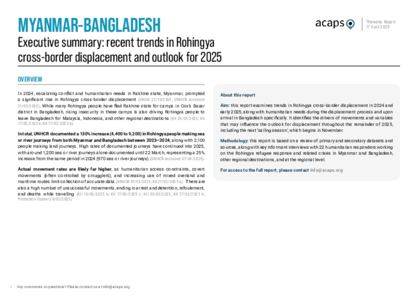Latest updates on country situation
04 September 2025
In late 2025, Rakhine state, with a population of over 3.6 million, is facing a worsening crisis. In central areas, 57% of families can no longer meet basic food needs, up from 33% at the end of 2024. Northern Rakhine is the hardest hit, with conflict, air strikes, and access constraints driving needs. Families are relying on potentially harmful coping strategies, such as debt, child labour, and human trafficking. Over 13% of children are acutely malnourished, while disease outbreaks such as acute watery diarrhoea and scabies are spreading, mainly in IDP camps amid declining healthcare assistance. (Health Cluster 01/09/2025, ECHO 01/09/2025, WFP 12/08/2025)
12 August 2025
Since late July 2025, heavy monsoon rains in Myanmar have triggered severe flooding and landslides, killing at least 16 people across Taungoo district, Bilin township, and Laiza town. Damage to homes, infrastructure, and farmland is widespread, with over 18,000 people displaced and overall 131,000 affected. Further heavy rainfall is forecast for the northern and central regions. (ECHO 06/08/2025, The Watchers 07/08/2025, UCA News 12/08/2025)
09 July 2025
Malaria cases are on the rise in Myanmar, particularly in Rakhine State, with over 1,000 cases and over 30 deaths so far in 2025. The outbreak has worsened because of the lack of mosquito nets, limited availability of malaria medication, and the need for civilians to move into forested, malaria-prone areas in search of food. Road blockades, restricted airport access, and suspended NGO support are further worsening the situation. (WHO 30/06/2025, The Irrawaddy 02/07/2025)
09 July 2025
Airstrikes and hostilities in northern Sagaing have displaced over 10,000 people since 14 June – many of them fleeing without food or belongings. Earthquake-related damages have forced people to seek shelter in forests, monasteries, and remote areas, where they continue to face harsh conditions and multisectoral needs, such as food, protection, and shelter. With roads blocked and river transport restricted as a result of conflict and insecurity, access to aid is limited. (OCHA 01/07/2025, The Irrawaddy 02/07/2025)
17 June 2025
Since June 2025, heavy monsoon rains and river overflows have caused widespread flooding in northern and western Myanmar, with Kachin state being the worst affected, followed by Rakhine state. In Kachin, floodwaters inundating mountainous villages and refugee camps have temporarily displaced over 23,000 people. In Rakhine state, the floods have affected around 7,500 people. By 11 June, at least five people had died as a result in Kachin. Additional flood impacts have been reported in Sagaing and Magway regions, where agricultural lands have sustained considerable damage. The rains have arrived unusually early this year, weeks before the typical peak in late June or July, resulting in premature flooding during a critical harvest season and leading to severe agricultural losses. The floods are worsening needs across conflict-affected and earthquake-hit areas where many shelters are unable to withstand heavy rain, increasing the risk of collapse, disease outbreaks, and water contamination. (OCHA 11/06/2025, ECHO accessed 17/06/2025, Examiner 06/06/2025)
30 April 2025
One month after a magnitude-7.7 earthquake struck Myanmar on 28 March 2025, women, girls, and children’s needs remain critical. Over ten million women and girls already needed humanitarian assistance before the earthquake, with 4.6 million women of reproductive age and 223,000 currently pregnant living in the affected areas. The earthquake damaged over 640 health facilities, preventing women’s access to crucial maternal and reproductive care, such as prenatal, postnatal, and urgent obstaetric services. Over 1.5 million adolescent girls face heightened protection risks, with overcrowded shelters lacking privacy, lighting, and safety measures. Around two million children require immediate assistance and protection. The earthquake also damaged over 800 schools and destroyed or rendered 279 non-functional, severely disrupting children’s access to education and safe learning environments. Conflict and insecurity further restrict humanitarian access, disrupt relief operations, and heighten protection risks for already vulnerable populations, particularly women, girls, and children. (UNFPA 25/04/2025, UNFPA 18/04/2025, UNICEF 18/04/2025)
05 March 2025
Healthcare needs in Myanmar are on the rise, particularly in the northwestern region. Since the acute watery diarrhoea outbreak in June 2024, nine states out of 17 have reported outbreaks of water- and vector-borne diseases. Clean water, medicine, and vaccine shortages have worsened the situation. In 2025, it is estimated that 12.9 million people will need healthcare assistance, while 1.2 million unvaccinated children under five are at high risk for vaccine-preventable diseases. Restrictions imposed by the military junta on transportation have aggravated the scarcity of medical supplies, particularly in Chin and Rakhine states and in Sagaing region. The number of displaced people in these regions is also increasing. Rakhine and Sagaing account for over 1.5 million of Myanmar’s 3.2 million IDPs. The US funding freeze is worsening the crisis, as it severely limits the ability of humanitarian organisations to deliver lifesaving health assistance to those in urgent need. With the rainy season approaching, conditions are expected to deteriorate even further. (WHO 28/02/2025, RFA 28/02/2025, UNHCR 18/02/2025)
current crises
in
Myanmar
These crises have been identified through the INFORM Severity Index, a tool for measuring and comparing the severity of humanitarian crises globally.
MMR007 - 2025 Earthquake
Last updated 23/11/2025
Drivers
Earthquake
Crisis level
Country
Severity level
4 High
Access constraints
1.0
MMR004 - Post-coup conflict
Last updated 23/11/2025
Drivers
Conflict/ Violence
Crisis level
Country
Severity level
4.2 Very High
Access constraints
1.0
MMR001 - Multiple crises
Last updated 23/11/2025
Drivers
Conflict/ Violence
Earthquake
Crisis level
Country
Severity level
4.3 Very High
Access constraints
1.0
MMR002 - Conflict in Rakhine
Last updated 23/11/2025
Drivers
Conflict/ Violence
Crisis level
Country
Severity level
3.8 High
Access constraints
1.0
MMR003 - Conflict in Kachin and Shan
Last updated 23/11/2025
Drivers
Conflict/ Violence
Crisis level
Country
Severity level
3.6 High
Access constraints
1.0
Analysis products
on
Myanmar
23 September 2025
Myanmar: humanitarian profiles of key townships affected by the March earthquake
DOCUMENT / PDF / 1 MB
This report examines whether the earthquake response met critical humanitarian needs according to sectoral thresholds defined by cluster benchmarks, including proxy indicators such as service coverage, market functionality, access to assistance, and what lessons can be drawn.
22 April 2025
Myanmar earthquake: Bago region pre-crisis profile
DOCUMENT / PDF / 370 KB
On 28 March 2025, a magnitude-7.7 earthquake hit Myanmar’s Sagaing region, with a subsequent magnitude-6.4 aftershock shaking the Mandalay region. This has led to a state of emergency in six states and regions: Bago, Magway, Mandalay, Nay Pyi Taw, Sagaing, and Shan. Prior to the earthquake, around two million people in Bago region were in need of humanitarian assistance.
22 April 2025
Myanmar: Exposure to seasonal hazards in earthquake-affected areas
DOCUMENT / PDF / 421 KB
Myanmar has recently been struck by a magnitude-7.7 earthquake and is approaching the start of its monsoon and cyclone seasons, with forecasts predicting above-average rainfall and temperatures. These challenging conditions, coupled with conflict, poverty, and diminished coping capacities, may present significant risks to the population.
17 April 2025
Myanmar-Bangladesh: trends in Rohingya cross-border displacement and outlook for 2025
DOCUMENT / PDF / 150 KB
This report examines trends in Rohingya cross-border displacement in 2024 and early 2025, along with humanitarian needs during the displacement process and upon arrival in Bangladesh specifically. It identifies the drivers of movements and variables that may influence the outlook for displacement in 2025.







